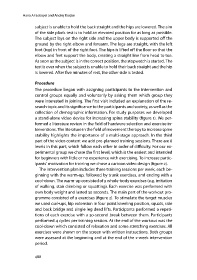Page 488 - Pedagoška vizija / A Pedagogical Vision
P. 488
Hana Al-Sobayel and Andrej Kocjan
subject is unable to hold the back straight and the hips are lowered. The aim
of the side plank test is to hold an elevated position for as long as possible.
The subject lays on the right side and the upper body is supported off the
ground by the right elbow and forearm. The legs are straight, with the left
foot (top) in front of the right foot. The hips is lifted off the floor so that the
elbow and feet support the body, creating a straight line from head to toe.
As soon as the subject is in the correct position, the stopwatch is started. The
test is over when the subject is unable to hold their back straight and the hip
is lowered. After five minutes of rest, the other side is tested.
Procedure
The procedure began with assigning participants to the intervention and
control groups equally and voluntarily by asking them which group they
were interested in joining. The first visit included an explanation of the re-
search topic and its significance to the participants and society, as well as the
collection of demographic information. For study purposes we developed
a stand-alone video device for increasing spine stability (figure 1). We per-
formed a literature review in the field of hardware selection and exercise in-
terventions. The literature in the field of movement therapy to increase spine
stability highlights the importance of a multi-stage approach. In the third
part of the video content we add pre-planned training sessions. There are 8
levels in this part, which follow each other in order of difficulty. For our ex-
perimental group we chose the first level, which is the easiest and intended
for beginners with little or no experience with exercising. To increase partic-
ipants‘ motivation for training we chose a cartoon video design (figure 2).
The intervention plan includes three training sessions per week, each be-
ginning with the warm-up, followed by trunk exercises, and ending with a
cool-down. The warm-up consisted of 9 whole-body exercises (e.g. imitation
of walking, stair climbing or squatting). Each exercise was performed with
own body weight and lasted 30 seconds. The main part of the workout pro-
gramme consisted of 9 exercises (figure 2). To stimulate the target muscles
we used curl-ups, hip extension in four point kneeling position, squats, side
and back bridge and single leg dead lifts. Participants performed 9 repeti-
tions of each exercise with a 30-second break between them. Participants
performed 4 cycles per training session. At the end of the workout was the
cool-down which consisted of relaxation and some stretching exercises. All
exercises were shown on the screen with written instructions. Both groups
were assessed at the beginning and at the end of the 2-week intervention
period.
488

